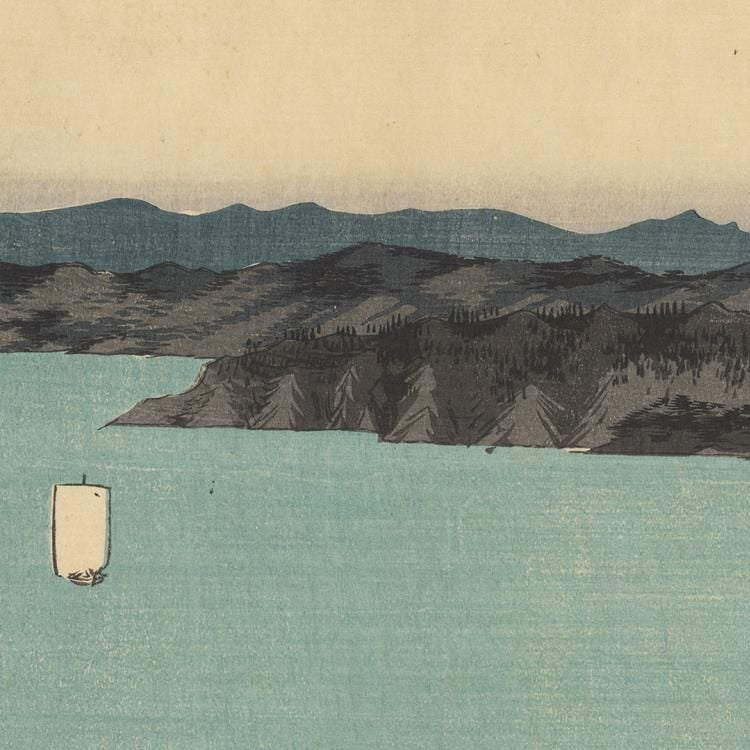See the exhibition
Hiroshige: artist of the open road is open 1 May – 7 September 2025.
About this guide
This guide is written using short, easy to read sentences.
It can be used by anyone, including visitors with accessibility needs and non-English speakers.
This guide takes you on a tour of the exhibition. It looks at 10 different pictures and objects.
A map of the exhibition shows you where to find them.
The exhibition has six sections. There is an introduction to each section.
Please let us know what you think about this guide. Tell a member of staff or email [email protected]
A large print guide containing the entire exhibition text is also available.
Introduction to Hiroshige: artist of the open road
Utagawa Hiroshige is a famous Japanese artist.
He was born a long time ago in a city called Edo.
People from all walks of life loved his pictures.
Artists around the world have also enjoyed his pictures and used them as a starting point for their own work.
Picture of Hiroshige
1. Picture of Hiroshige by Kunisada
This picture of Hiroshige was made just after he died.
It shows that his friends saw him as a kind, friendly and religious man.
Introduction to Hiroshige's road to fame
Hiroshige's parents died when he was 12.
His father had worked in the fire department.
A chief in the fire department taught Hiroshige to paint.
Hiroshige lived at a time when cities were growing in Japan.
But there was sometimes not a lot to eat and people were worried about foreign countries attacking them.
Picture of a mountain and river by Hiroshige
2. Picture of a mountain and river by Hiroshige
This is a view of the famous Japanese volcano Mount Fuji.
Hiroshige included it in many of his pictures.
He made the yellow sky and dark blue water in this picture with a method called bokashi in Japanese.
You can watch an artist showing how this was done in the film below.
Printer's pad.
3. Printer's pad
This is the type of pad the printer would have used to make the yellow sky and blue sea.
It is made of bamboo bark and paper.
Introduction to Picturing the open road
Travel abroad had been forbidden for a long time in Japan.
But during Hiroshige's lifetime many people began to take trips inside the country.
Hiroshige went on drawing trips.
He made beautiful landscape pictures. They often include people going about their daily lives.
4. Picture of a sudden rain shower by Hiroshige
4. Picture of a sudden rain shower by Hiroshige
A shower surprises people walking along the highway.
The rain beats down on them and the bamboo trees.
Men and trees bend under the weight of the rain.
5. Picture of an owl and a flying bird by Hiroshige
5. Picture of an owl and a flying bird by Hiroshige
Hiroshige included a poem by a Japanese poet called Hachijintei on this picture of an owl:
Sailing right along
on a three-day crescent moon,
the long-eared owl longs
for an earful of music:
the pines humming in the wind.
6. Picture of mountains and the sea by Hiroshige and a fan frame
6. Picture of mountains and the sea by Hiroshige and a fan frame
In the sticky heat of the Japanese summer everyone used fans to keep cool.
They were made of prints stuck onto a bamboo frame with a handle.
Not many people kept these fans.
So this is one of the few pictures that Hiroshige made for fans to survive.
7. Picture of two men on a river by Hiroshige
7. Picture of two men on a river by Hiroshige
Men from a nearby village work in a peaceful landscape.
Their boats drift down the gentle Narai River.
One boat is piled with charcoal. The other is made of logs.
The rising moon can be seen through the branches of a tree.
8. Picture of a large black fish by Hiroshige
8. Picture of a large black fish by Hiroshige
An enormous black fish seems to leap high into the air.
People used to wave banners like this during the Boys' Day Festival.
Hiroshige often puts a large object at the front of his pictures like this.
The rooftops and mountains behind seem very far away.
9. Picture of the river without the two men by Abe
9. Picture of the river without the two men by Abe
The Japanese artist Koya Abe lives in New York.
This is his version of Hiroshige's picture of two men on a river.
In his picture Abe shows how sad he felt when there was a huge earthquake in Japan.
The boatmen, village and tree branches have gone.
10. Picture of a large red fish by Allchurch
10. Picture of a large red fish by Allchurch
British artist Emily Allchurch based this picture on Hiroshige's picture of a huge fish banner.
She took lots of photos in Japan to make her own version of this picture.
She put the photos together on a computer.





